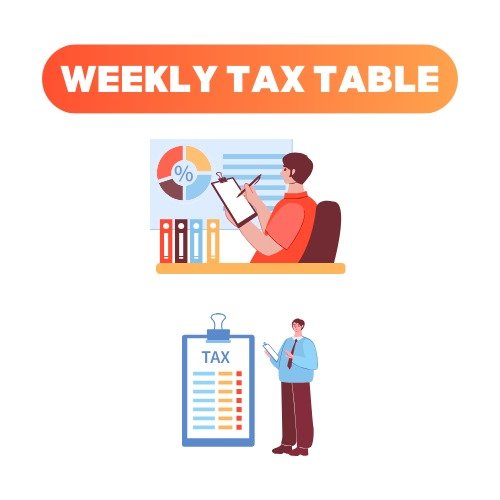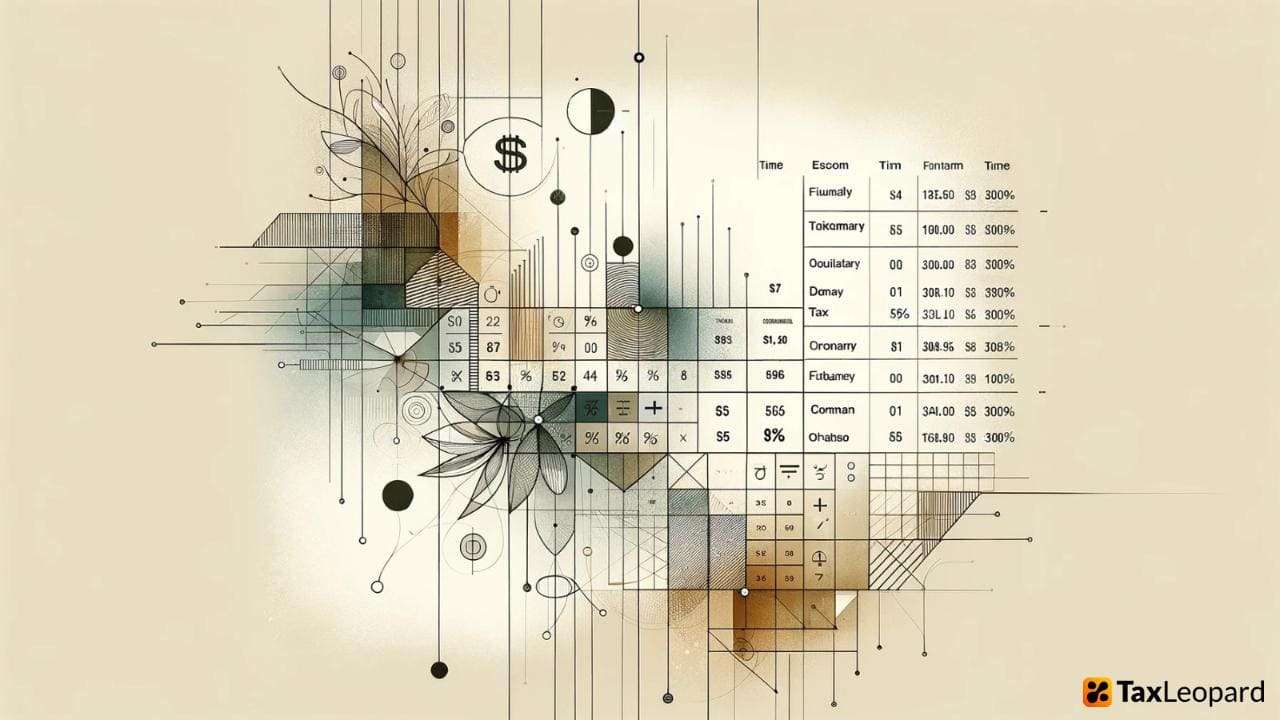Navigating the complexities of tax withholding can often feel like trying to find your way through a labyrinth without a map. With the Australian Taxation Office (ATO) updating regulations and tax rates annually, staying informed is crucial for both employers and employees to ensure compliance and financial efficiency. The Weekly Tax Table for 2023 is a critical tool designed to simplify this process, providing clear guidelines on the correct amount of tax to withhold from payments made on a weekly basis. This includes considerations for PAYG withholdings, tax offsets, and adjustments for study and training support loans, among others. Whether you’re managing payroll for a large organization or just trying to understand your income tax obligations, the 2023 Weekly Tax Table offers a comprehensive solution. Our article delves deep into these tables, offering a complete guide to help you accurately calculate the tax to be withheld, ensuring you or your employees are not over or underpaying tax throughout the financial year.
Importance of Tax Tables
Tax tables play a pivotal role in ensuring that individuals and businesses understand their tax obligations. These tables provide a clear breakdown of how much tax is owed based on different income levels. Without them, calculating one’s tax liability would be an overwhelming challenge, leading to potential discrepancies, underpayments, or overpayments. The ATO weekly tax table 2023 represents a pivotal shift in the Australian Taxation Office’s approach to keeping taxpayers informed. Serving as a comprehensive guide, the weekly tax table 2023 provides up-to-date data on tax withholding amounts, ensuring employers and employees alike can navigate their financial responsibilities with confidence.
Relevance of ATO Weekly Tax Table
As the world becomes increasingly digital, the prominence of the weekly tax table in 2023 cannot be overstated. It not only signifies the ATO’s commitment to leveraging technology for better taxpayer service but also reflects the broader trend in the financial world towards real-time, accessible data. Whether you are an employer aiming to streamline payroll processes or an employee keen on understanding your deductions, turning to the weekly tax table in 2023 is a step in the right direction. This table, thus, plays a crucial role in simplifying taxation processes for all involved parties.
Understanding ATO Weekly Tax Table

Definition
The ATO Weekly Tax Table is a detailed document provided by the Australian Taxation Office that indicates the amount of tax to be withheld from an employee’s weekly wages based on their earnings.
Purpose
Its main purpose is to assist employers in deducting the right amount of tax from their employees’ weekly paychecks. By following this table, employers help ensure that their employees don’t face any unexpected tax bills and that the government consistently receives its tax revenue throughout the year.
Highlights of ATO Weekly Tax Table 2023
Major Changes from the Previous Year
The Australian Taxation Office (ATO) introduced several key changes in the Weekly Tax Table for the 2023 tax year:
- Removal of the Self-Education Expenses Threshold: Prior to July 1, 2022, there was a $250 non-deductible threshold for work-related self-education expenses. This threshold has been eliminated from the 2022–23 income year, affecting both individual tax returns and fringe benefits tax. Taxpayers no longer need to record non-deductible self-education expenses that were previously offset against this threshold.
- Revised Calculation for Working from Home Deductions: The fixed rate method for calculating deductions for working-from-home expenses has been revised. The new rate is $0.67 per work hour, effective July 1, 2022. This change includes an increase in the rate per work hour, changes in the types of expenses it covers, alterations in record-keeping requirements, and the removal of the necessity to have a dedicated home office.
- End of Low and Middle Income Tax Offset (LMITO): The LMITO was discontinued on June 30, 2022, and is no longer available for the 2022–23 income year.
- Veterans’ Superannuation (Invalidity Pension) Tax Offset: This non-refundable tax offset, known as the Veterans’ Super (Invalidity Pension) Tax Offset (VSTO), ensures that veterans and their beneficiaries do not pay additional tax due to the Douglas court decision. It has been applicable since the 2007–08 income year, and taxpayers do not need to apply for it as it is assessed after lodging the tax return.
Key Figures and Rates
The key figures and rates for the Australian Taxation Office’s (ATO) Weekly Tax Table for the 2022–2023 financial year are as follows: Resident Tax Rates:
| Income | Tax |
|---|---|
| $0 – $18,200 | Nill |
| $18,201 – $45,000 | 19 cents for each $1 over $18,200 |
| $45,001 – $120,000 | $5,092 plus 32.5 cents for each $1 over $45,000 |
| $120,001 – $180,000 | $29,467 plus 37 cents for each $1 over $120,000 |
| over $180,001 | $51,667 plus 45 cents for each $1 over $180,000 |
Note: These rates do not include the Medicare levy of 2%.
Weekly, Fortnightly, and Monthly Tax Tables:
- Weekly Tax Table, (NAT 1005)
- Fortnightly Tax Table, (NAT 1006)
- Monthly Tax Table, (NAT 1007)
- Tax Table for Daily and Casual Workers, (NAT 1024)
Medicare Levy Adjustments:
- Weekly Tax Table with No and Half Medicare Levy (NAT 1008)
- Fortnightly Tax Table with No and Half Medicare Levy (NAT 74228)
- Medicare Levy Adjustment Weekly Tax Table (NAT 1010)
- Medicare Levy Adjustment Fortnightly Tax Table (NAT 1011)
- Medicare Levy Adjustment Monthly Tax Table (NAT 1012)
Superannuation Payments:
- Tax Table for Superannuation Lump Sums (NAT 70981)
- Tax Table for Superannuation Income Streams (NAT 70982)
For specific income levels, the estimated tax amounts are as follows:
- For an income of $18,000, the tax is $0.
- For an income of $45,000, the tax is $5,092.
- For an income of $120,000, the tax is $29,467.
- For an income of $180,000, the tax is $51,667.
- For an income of $250,000, the tax is $83,167.
How to Use the ATO Weekly Tax Table
Step-by-step Process:
- Acquire the Table: Start by obtaining the most recent ATO Weekly Tax Table for the year 2023, either from the official ATO website or from your accountant.
- Identify Gross Income: Determine your weekly gross income before any deductions.
- Locate Income Bracket: Using the table, find the range that your weekly income falls within.
- Calculate Tax: The table will specify how much tax is payable based on your weekly gross income.
- Apply Additional Charges: Ensure that you include any additional levies or fees that the ATO has indicated.
Importance of Accurate Tax Calculation
1. Legal Compliance:
Ensuring accurate tax calculations is essential to maintaining legal compliance. Governments worldwide have strict regulations and penalties for those who fail to accurately report and pay their taxes. Misrepresentations, whether intentional or accidental, can result in significant fines, legal action, and a tarnished reputation. It’s imperative to stay updated with ever-changing tax laws to avoid such complications.
2. Financial Integrity:
An accurate tax calculation is fundamental to ensuring financial integrity. When businesses or individuals overestimate their taxes, they may overpay, leading to unnecessary financial losses. Conversely, underestimating can result in owing back taxes with added interest. Maintaining precise records and calculations ensures that one’s finances are both transparent and trustworthy.
3. Trustworthiness & Reputation:
Being transparent and consistent in tax reporting enhances an individual’s or a business’s reputation. Stakeholders, including investors, partners, and customers, trust entities that uphold financial honesty. Accurate tax calculations are indicative of responsible financial management, which can lead to greater trust and credibility in the market.
4. Decision-making & Planning:
For businesses and individuals alike, accurate tax calculations play a significant role in financial decision-making and future planning. Understanding tax liabilities allows for informed decisions about investments, expansions, savings, and more. Without this clarity, it’s challenging to plan strategically and make effective financial choices.
Common Mistakes to Avoid in Tax Brackets
Understanding tax brackets, especially for the year 2023, is crucial to navigating the complexities of filing taxes in Australia. The Australian Taxation Office (ATO) outlines specific tax brackets that determine how much you owe based on your income. Here are common mistakes to avoid:
- Not updating your knowledge of the ATO tax brackets for 2023 can lead to incorrect filings.
- Assuming tax brackets from previous years apply, without checking the latest ATO tax brackets, is a frequent oversight.
- Failing to consider all sources of income can misplace you in the wrong tax bracket.
- Overlooking potential deductions that could lower your taxable income and possibly place you in a more favourable tax bracket.
- Ignoring the benefits of understanding how tax brackets work can result in paying more tax than necessary.
- Neglecting to seek professional advice when confused about which tax bracket you fall into, especially with the updates in tax brackets Australia for 2023, can be costly.
By steering clear of these pitfalls, taxpayers can better manage their obligations and potentially reduce their tax liabilities. Always refer to the ATO for the most current information on tax brackets to ensure compliance and optimize your tax position. Remember, while the ATO Weekly Tax Table provides a helpful guideline, it’s always a good idea to consult with a professional accountant or tax adviser for personalized advice.
Comparing 2022 and 2023 Tax Tables
Significant Changes
From 2022 to 2023, there were several amendments in the tax brackets, most notably the adjustments for inflation. There was also a revision of certain deductions, aiming to simplify the tax process and reduce loopholes. The introduction of new tax reliefs for specific sectors was another significant change to promote economic recovery post-pandemic. Additionally, there were notable expansions in tax credits for child care and sustainable energy solutions, reflecting the government’s focus on supporting families and pushing for greener alternatives. These shifts in 2023 highlight a move towards addressing income inequality and environmental concerns through the tax system.
Trends in Taxation
The trend in taxation for 2023 notably leaned toward progressive reforms. Authorities worldwide recognized the widening wealth gap and sought to ensure a more equitable distribution of tax burdens. As a result, there was a global inclination towards taxing the ultra-rich at higher rates while providing relief and incentives for the middle class and the economically disadvantaged. Moreover, eco-taxes gained traction. Governments started imposing levies on carbon footprints and non-sustainable practices to foster a greener economy. Digital taxation also saw a rise, targeting major tech conglomerates, as countries adapted to the rapidly evolving digital landscape.
Benefits of Using ATO’s Weekly Tax Table
- For Employers: The ATO’s weekly tax table streamlines the process of withholding the correct amounts from employees’ pay. This reduces the risk of errors and the potential for penalties. Additionally, it helps employers stay updated with any changes in tax regulations, ensuring they remain compliant.
- For Employees: From an employee’s perspective, the weekly tax table ensures that the correct tax amount is withheld from their pay. This reduces the chances of having a large tax bill at the end of the financial year or, conversely, of overpaying taxes.
Digital Transformation of ATO
The Shift to Online Platforms
The Australian Taxation Office (ATO) has embraced the wave of digital transformation sweeping across industries worldwide. With the shift towards online platforms, the ATO aims to simplify tax procedures and improve the user experience. Traditionally, taxpayers had to navigate complex paper forms, leading to potential errors and inefficiencies. The introduction of online platforms means taxpayers now have a more streamlined approach with intuitive interfaces and instant feedback mechanisms. This digital shift not only enhances accessibility but also promotes transparency in tax dealings, ensuring that taxpayers and businesses have access to up-to-date information at their fingertips.
Advantages of Digital Tax Tables
- Real-time Access: Provides immediate access to accurate tax rates and calculations.
- Accuracy: Eliminates the guesswork associated with manual tables, reducing miscalculations.
- Prompt Updates: Easily updated to reflect legislative changes without waiting for new print versions.
- Eco-Friendly: Reduces paper waste, contributing to environmental conservation.
- Accessibility: Available on a variety of devices, including mobiles and tablets.
- Convenience: Allows taxpayers to access essential information anytime, anywhere, facilitating easier tax planning and compliance.
Conclusion
The ATO weekly tax table for 2023 stands as a testament to the continued evolution of Australia’s tax system. It not only ensures clarity and precision for employers and employees but also exemplifies the broader trend of the ATO embracing digital transformation. With the weekly tax table 2023, users can experience real-time updates and seamless integration into modern accounting systems, leading to a more efficient and accurate taxation process. As we reflect on the transition from the 2022 tables, it’s evident that the weekly tax table 2023 is geared towards simplifying tax responsibilities while promoting a progressive and transparent system for all.
FAQs
1. What is the main purpose of the ATO Weekly Tax Table?
It helps employers determine the correct tax amount to withhold from an employee’s weekly wages.
2. How often does the ATO update its tax tables?
Typically, the ATO updates its tax tables annually, reflecting any changes in tax legislation or rates.
3. Where can I find the ATO Weekly Tax Table for 2023?
It is accessible via the official ATO website or through authorized tax agents.
4. Do I always need to use the latest tax table?
Yes, to ensure compliance and accuracy, it’s essential to use the most recent version.
5. How does the digital transformation of ATO benefit users?
Digital platforms make it easier to access, understand, and implement tax information, leading to more accurate and efficient processes.




